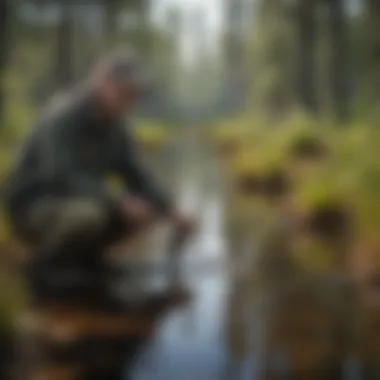Exploring the Intricacies of Bogs in the United States


Intro
Bogs, often overlooked in the grand tableau of America's ecosystems, are intricate wetlands characterized by their unique hydrology, flora, and fauna. Understanding these ecosystems is crucial for both ecological and cultural reasons, as they play significant roles in biodiversity and climate regulation. However, these fascinating landscapes are under threat, necessitating a closer inspection of their dynamics and a commitment to their preservation.
In this discussion, we will explore the different types of bogs found in various regions of the United States, their ecological importance, the rich biodiversity they support, and the challenges they face due to human activity, particularly climate change. We will also examine the historical significance of bogs, offering insights into how they have shaped and been shaped by human interactions over the years.
Armed with this understanding, we aim to emphasize the need for conservation and sustainable practices that acknowledge the delicate balance of these ecosystems. Let’s embark on this journey to uncover the intricacies of bogs, bringing awareness and appreciation to these crucial natural resources.
Prolusion to Bogs
Bogs represent a unique and significant aspect of the ecological landscape in the United States. These wetland systems are not just a mere accumulation of stagnant water; they serve vital functions within their respective environments. Understanding the intricacies of bogs is pivotal for forestry professionals and academics alike, as it leads to insights into ecological health, biodiversity, and the impacts of climate change. This discussion aims to peel back the layers of what makes bogs essential, both ecologically and culturally.
Key points to cover:
- Bogs are characterized by their waterlogged conditions and rich, organic substrates that influence plant and animal life.
- They host a unique assortment of flora and fauna, contributing to biodiversity and helping maintain ecosystem balance.
- Recognizing the challenges faced by bogs, such as climate change and human encroachment, is crucial for developing effective conservation strategies.
- Bogs have cultural and historical significance, often intertwined with indigenous practices and regional folklore, adding depth to their importance beyond mere ecology.
In short, the robust examination of bogs helps frame our understanding of a critical ecological niche that grows ever more significant as environmental challenges mount. This exploration is not just an academic endeavor; it bears practical implications for habitat conservation, climate awareness, and the sustainable use of our natural resources.
Definition and Characteristics of Bogs
Bogs are defined primarily by their saturated ground conditions, which inhibit the decomposition of organic material. This results in the formation of peat, a spongy accumulation of dead plant material. The characteristics of bogs vary across different regions, influenced by local climate, geography, and hydrology.
- Waterlogged Conditions: Bogs typically maintain a high water table, resulting in anaerobic conditions. This aspect is key in shaping the kind of vegetation found.
- Sphagnum Moss: A hallmark of many bogs, sphagnum moss plays a significant role in water retention and provides habitat for various microbes and invertebrates.
- Acidic Environments: With little nutrient input, bog waters tend to be acidic, often leading to unique plant communities that are adapted to survive under such conditions.
The combination of these characteristics fosters the unique ecosystems found in bogs, characterized by specialized species of plants such as cranberries, some orchids, and various hardy shrubs.
The Formation of Bogs
The evolution of bogs is a complex interplay of climatic, geographic, and hydrological factors. Bogs typically form in conditions where water is trapped in the soil, which leads to anaerobic conditions that favor the accumulation of peat. The following factors contribute to bog formation:
- Climate: Cool and moist climates are conducive to bog formation. Regions with prolonged periods of precipitation and limited evaporation create ideal conditions for water accumulation.
- Topography: Flat or gently sloping areas that allow for water to pool tend to support bog growth. Elevation affects drainage; low-lying areas naturally harbor more water.
- Vegetation Cover: The initial establishment of peat-forming vegetation like sphagnum moss can start the process of bog formation by slowing down water movement, allowing more organic materials to accumulate.
- Hydrology: The water should remain at or near the surface, preventing oxygen from reaching the organic matter, which would otherwise decompose. Factors like groundwater discharge and surface water input play critical roles in sustaining this hydrology.
Together, these elements create a dynamic habitat that supports distinctive ecologies, which require further examination to appreciate their full scope within environmental studies.
Types of Bogs across the United States
Understanding the various types of bogs in the United States is crucial for appreciating their ecological roles and complexities. Each type of bog possesses unique features that contribute to biodiversity, carbon storage, and water filtration, making them invaluable ecosystems. By categorizing these bogs, we can highlight their individual significance, which is essential for conservation efforts and educational initiatives.
Northern Bogs
The northern bogs, primarily found in the cold, moist regions of the northern United States, play a prominent role in the ecological landscape. These bogs typically feature Sphagnum moss, which forms thick mats that store water and create unique habitats for various species. Northern bogs are often home to carnivorous plants like the pitcher plant and the sundew, which thrive in nutrient-poor conditions. The diverse plant life supports an array of bird species, amphibians, and insects that rely on this environment for sustenance.
Moreover, northern bogs act as significant carbon sinks, absorbing and holding carbon dioxide. This function is increasingly critical as the world seeks solutions to combat climate change. The preservation of these ecosystems is vital not only for their unique biodiversity but also for their role in mitigating carbon emissions.
Coastal Bogs
Coastal bogs are typically nestled along the intertidal zones, where saline and freshwater systems meet. These wetlands exhibit a blend of salt-tolerant and freshwater vegetation, showcasing a unique diversity distinct from other bog types. Coastal bogs provide essential buffering against storm surges, making them vital for coastal communities. Their vegetation helps stabilize shorelines, prevent erosion, and protect inland ecosystems from saline intrusion.
This zone is also a playground for a variety of birds and marine life, offering feeding and breeding grounds. Sea lavender (Limonium spp.) and other halophyte species thrive in these coastal environments, supporting the intricate web of life that calls this habitat home. The delicate balance of these ecosystems makes them especially sensitive to changes in water quality, temperature, and coastal land use.
Sphagnum Bogs


Sphagnum bogs are characterized by the dominance of Sphagnum mosses, which create a distinct acidic environment. These bogs are often found in cooler higher latitudes, demonstrating unique hydrology and chemistry. They play an essential role in water regulation, as they can hold large amounts of water, releasing it slowly into the surrounding landscape. This property is crucial for maintaining local hydrological cycles and supporting adjacent ecosystems.
Moreover, Sphagnum bogs are rich in biodiversity. They host a variety of plant species, including orchids, and provide habitat for a myriad of mosses, lichens, and wildlife. Notably, these bogs support unique insect life and several amphibian species which thrive in the moist, sheltered environment. The carbon sequestration potential of Sphagnum bogs is also significant, playing a crucial role in climate regulation.
"Bogs act not just as a barrier against climate change but as dynamic ecosystems that reflect the health of our environment."
In summary, the types of bogs across the United States each contribute uniquely to ecological balance, climate stability, and biodiversity. Understanding their characteristics is paramount to their conservation and appreciation. Their intricate roles in the environment underscore the need for continued research and protection efforts.
Ecological Importance of Bogs
Bogs play a cornerstone role in the ecology of their respective regions, acting as unique habitats that significantly contribute to the health of our natural environment. Understanding their importance necessitates examining various aspects that include biodiversity, climate regulation, and water quality management. These ecosystems, though sometimes overlooked, are brimming with life and ecological services that benefit both the environment and humanity.
Biodiversity in Bogs
Bogs are home to a fascinating array of flora and fauna. While they may look simple at first glance, a closer inspection reveals a complex web of life. The Sphagnum moss, often dominating these ecosystems, provides a foundation for diverse plant species, including carnivorous plants like sundews and pitcher plants. Such plants have evolved to thrive in nutrient-poor conditions, showcasing nature's ingenuity.
Other plant species commonly found in these habitats include various shrubs and small trees, which offer shelter and food for numerous animal species. Birds such as the common yellowthroat nest in the dense vegetation, while mammals like the bog turtle find refuge among the wetland's intricate structures. These ecosystems not only provide habitat but also serve as critical migration paths for various wildlife.
The loss of bogs means the potential loss of many species that are uniquely adapted to these environments. Such biodiversity is essential, as it maintains ecological balance and offers resilience against environmental changes.
Carbon Sequestration and Climate Regulation
One of the lesser-known but vital functions of bogs is their ability to sequester carbon. Bogs capture carbon dioxide from the atmosphere, storing it in the form of plant biomass and in the peat that accumulates over centuries. This process is significant in the fight against climate change. To put it bluntly, these ecosystems work as a natural carbon sink.
According to research, peatlands, which include bogs, cover approximately 3% of the Earth's land surface yet store about one-third of the world's soil carbon. This aspect underscores the irreplaceable role that bogs play in mitigating greenhouse gas emissions. However, as these ecosystems deteriorate due to various threats, their capacity to sequester carbon diminishes, exacerbating climate issues.
Water Regulation and Quality
Bogs are also champions of water management. They act as sponges, absorbing excess rainwater during wet periods and slowly releasing it during drier spells. This mechanism helps stabilize water levels in nearby rivers and lakes, reducing the risk of flooding. Moreover, the unique composition of bogs allows them to filter pollutants, thus improving water quality in surrounding areas.
The intricate plant life in these wetlands provides a habitat for organisms that contribute to this filtering process. By breaking down harmful substances and absorbing nutrients, bogs play a critical role in maintaining the health of local water systems. Without these ecosystems, many areas could experience degraded water quality, leading to adverse effects on both human health and aquatic ecosystems.
"Bogs are more than mere soaking ground; they are vibrant ecosystems that serve up multiple ecological benefits and a treasure trove of biodiversity."
Threats Facing Bogs
The protection of bogs is paramount, yet these unique ecosystems are under siege from a variety of sources. Recognizing the specific threats that bogs face sets the stage for informed conservation efforts. This section will delve into the most pressing issues, namely climate change, human activity, and the introduction of invasive species.
Impact of Climate Change
Climate change is an undeniable foe for bogs. The transformation of weather patterns and the steady rise in global temperatures are not just abstract concepts; they manifest in very real ways. As temperatures climb, the delicate balance of moisture that bogs rely upon is disrupted. Increased evaporation rates lead to a decline in water levels.
Given that many bogs are specifically adapted to very stable conditions, even slight changes can trigger significant ecological consequences. The flora and fauna that thrive in these environments often struggle to adapt quickly enough to the pace of change, leading to a decline in biodiversity.
One major consequence of climate change is the increased risk of wildfires. When bogs dry out, they can become susceptible to catching fire, leading to loss of habitat and carbon release - a double whammy for an already delicate ecosystem.
Human Development and Land Use
The expansion of urban environments presents substantial challenges for bog ecosystems. As cities spread their tendrils into natural landscapes, bogs often play the role of collateral damage. Residential developments, agriculture, and infrastructure projects frequently encroach upon these ecosystems, fragmenting habitats and putting immense pressure on the flora and fauna within.
Furthermore, land use changes typically result in the draining of wetlands to make way for agricultural production or housing, which directly reduces the area of viable bog habitats. As habitats become more fragmented, species that were once able to thrive in concert now find themselves isolated, leading to a decrease in genetic diversity and resilience.


This intersection of development and ecological need presents a challenge: how to balance the demand for land with the necessity of conserving these biodiverse regions. Protecting bogs is an uphill battle when economic growth often takes priority over environmental protection.
Invasive Species
Invasive species are a wolf in sheep’s clothing when it comes to ecosystems. These non-native species often sneak into wetland areas, thriving in conditions that tend to outcompete local flora. For example, plants like purple loosestrife can disrupt the natural equilibrium of bog plants, leading to the dominance of fewer species over time.
Invasive animals can have equally harmful effects. They can prey on native species, introduce diseases, or alter habitat structures. For instance, the impact of feral pigs on bog ecosystems can be devastating; they root around in the soil, destroying plant life in the process. This leads to not only the loss of biodiversity but also affects water quality and hydrology in the bog.
Addressing the threat of invasive species requires ongoing vigilance and proactive management strategies.
"To combat these threats effectively, community engagement and rigorous research are essential components of conservation strategies."
Conservation Efforts for Bogs
Conservation efforts for bogs are essential in preserving these unique ecosystems that play a pivotal role in our environment. The ecological benefits of bogs—ranging from carbon storage to water purification—are immense, yet they face numerous threats from climate change and human activities. As a result, a robust strategy for conservation not only safeguards biodiversity but also mitigates the impacts of climate change, highlighting the intrinsic value of bogs in a rapidly changing world.
Government Policies and Protection
Policies at the governmental level are crucial in the fight to protect bog environments. Agencies such as the United States Fish and Wildlife Service work tirelessly to designate bogs as protected areas, recognizing them under various environmental protection acts. The Clean Water Act serves to monitor and preserve water quality within bog regions, while the Endangered Species Act includes provisions for protecting species that rely on bogs for habitat.
One effective approach is the implementation of land-use planning, integrating bog conservation efforts into broader environmental management strategies. By establishing regulations that restrict development in vulnerable areas, governments can ensure that these ecosystems remain intact. Additionally, funding initiatives aimed at restoring damaged bogs also play a significant role. These efforts can include rewetting drained bogs, fighting invasive species, and restoring native vegetation.
In this regard, the collaboration between federal, state, and local governments faces both challenges and successes. Sometimes, bureaucratic inertia slows down essential actions. Nevertheless, when effective policies are in place, the positive outcomes can be substantial, offering a glimmer of hope for the future of these ecosystems.
Community Involvement in Conservation
Community engagement is another pillar of effective conservation efforts for bog environments. Local communities often serve as the first line of defense against threats to bogs through grassroots initiatives and educational programs. When residents understand the importance of bogs, they become more invested in their protection and preservation. This connection to their environment creates a sense of responsibility and ownership.
One successful example comes from the community-driven initiatives found in New England. In many of these regions, citizens have organized clean-up drives, conducted bio-blitzes to catalog biodiversity, and lobbied local governments for protective measures. Partnerships with conservation organizations can amplify these efforts, bringing in expertise and additional resources.
Moreover, education around bogs can foster a deeper appreciation for these unique ecosystems. Programs in schools that focus on local bog ecosystems raise awareness among children and their families. This understanding shapes future generations who will advocate for conservation; planting seeds for long-term protection.
While individuals may feel powerless against broader environmental challenges, local actions often lead to collective progress. Community involvement creates a robust network of vigilance and action that amplifies conservation efforts, proving that every small step counts.
"Conservation is a state of harmony between men and land." - Aldo Leopold
Ultimately, combining government policies with active community involvement creates a comprehensive approach to restoring and maintaining bogs, ensuring they will thrive for years to come. To protect our bogs is to protect a cornerstone of ecological balance in the United States.
Cultural and Historical Significance of Bogs
Bogs are much more than just waterlogged landscapes; they hold deep connections to culture, history, and identity. For centuries, these unique wetlands have played a pivotal role in the lives of various communities, influencing their practices, beliefs, and understanding of the environment. This section digs into the rich tapestry of cultural significance that bogs have woven into the fabric of society, focusing on two key areas: their importance in indigenous cultures and their portrayal in literature.
Bogs in Indigenous Cultures
Indigenous communities have long regarded bogs as sacred spaces, teeming with both resources and spiritual meaning. For example, the Algonquin tribes of the Northeast often shared their knowledge of bog ecosystems, understanding their intricate balance. They utilized various plants found within bogs, like cranberry and sweet gale, for both sustenance and medicinal purposes, illustrating a connection to the land that emphasizes harmony and respect.
"The earth does not belong to us; we belong to the earth."
This adage captures the essence of how these communities regard their relationship with bogs. The cultural practices centered around these wetlands include seasonal rituals where people would gather to honor the land before harvesting.
Furthermore, ceremonies held in bog areas often incorporated stories and traditions that conveyed the significance of these habitats, weaving them into the larger narrative of identity and community resilience. Bogs thus serve not merely as physical spaces but as cultural cornerstones, fostering a shared heritage and a deeper understanding of ecological stewardship.
Literary Representations of Bogs


Bogs also find their representation in literature, where they often embody a myriad of themes such as mystery, transition, and the untamed aspects of nature. Writers have depicted bogs as more than mere backgrounds; they are settings rich with symbolism. In W.H. Auden's work, bogs can evoke feelings of enigma, representing places of introspection and change. In contrast, Seamus Heaney's poems like "Digging" use the imagery of peat and trowels to connect personal identity with the very soil, echoing the labor and love poured into the land.
The interplay between man and nature in literature often highlights the bogs’ duality—both nurturing and harsh—reflecting human emotions and complexities. Furthermore, in folklore, bogs are often associated with mystical creatures and hidden treasures, highlighting human fascination and fear of the unknown. As a result, they serve as a canvas for exploring deeper philosophical inquiries about existence and the essence of hope.
In summary, the cultural and historical significance of bogs cannot be understated. They are woven into the cultural narratives of indigenous peoples and enrich our literary landscapes, fostering a deeper connection between the natural world and human experience. Recognizing this multifaceted role is crucial not only for understanding bogs themselves but also for appreciating the fabric of history that surrounds them.
Bogs as Educational Resources
Bogs serve as remarkable educational founts, offering profound insights not just about their unique ecology, but also concerning broader environmental principles and conservation strategies. They are living laboratories where scholars and individuals alike can unravel the intricate threads connecting flora, fauna, and the larger ecosystem. Importantly, the multifaceted nature of bogs makes them valuable tools in various educational settings, from primary schools to advanced environmental studies.
Field Studies and Educational Programs
Field studies in bogs are a hands-on way to grasp the complex interactions in these wetland ecosystems. Educational programs take many forms, from local school trips to graduate-level research initiatives. Students engage with the material in a way that's different from traditional classroom settings, directly observing how bogs function as both habitats and carbon sinks.
Key Elements of Field Studies:
- Biodiversity Workshops: Participants witness firsthand the myriad species that thrive in bogs. This exposure can ignite curiosity about life sciences.
- Water Quality Assessments: Through studying the unique water qualities found in bogs, students learn about chemical cycles and the impact of pollutants.
- Sustainable Practices: Students can delve into eco-friendly approaches to managing and preserving these vital ecosystems.
An intriguing aspect of field studies is their ability to foster a sense of stewardship among participants. By connecting personal experiences to scientific observations, individuals often leave with a heightened sense of responsibility toward the environment. This connection to nature can inspire grassroots conservation efforts in their communities.
Engaging the Community through Awareness Programs
Awareness programs focused on bog ecosystems can play an essential role in educating the masses about the importance of these environments. Community engagement initiatives contribute to understanding and appreciation of bog systems, while addressing misconceptions and raising awareness about conservation efforts.
Essential Components of Awareness Programs:
- Workshops and Lectures: Bringing in experts to speak on bog ecology, the role of these wetlands in climate regulation, and species preservation can help bridge the knowledge gap.
- Nature Walks and Guided Tours: These activities offer locals a close encounter with their nearby bogs, encouraging an emotional connection to the environment.
- Social Media Campaigns: Leveraging platforms such as Facebook and Reddit can spread the word about the value of bogs, reaching diverse audiences that otherwise may not engage with environmental issues.
"Educational programs about bogs provide a unique blend of excitement and knowledge, serving to cultivate both awareness and appreciation for these ecological treasures."
Involving the community not only enhances understanding of bogs but also cultivates partnerships for conservation. The more people learn about the significance of these ecosystems, the more likely they are to advocate for measures that protect them from threats like climate change and urban development.
In summary, bogs are more than just a landscape; they are avenues of education and community engagement, fostering a better understanding of our environment that extends far beyond the bog itself.
Future of Bogs in the United States
Bogs play an underappreciated role in our ecosystems. As we step into an era where environmental degradation is commonplace, understanding the future of these unique wetland systems becomes paramount. With ongoing climate shifts and pressures from urban development, ensuring the survival and health of bogs is no small feat. This section will elaborate on new research directions and highlight the need for sustainable practices as vital components of long-term conservation efforts.
Research and Technological Advances
Recent years have brought a wave of technological innovation that holds promise for bog preservation. Remote sensing technology stands out as a game-changer. By utilizing satellite imagery and ground-based sensors, researchers can now monitor bog health with greater precision. This allows for the early detection of subtle changes in vegetation cover and water levels, which are crucial indicators of ecosystem stability.
"The use of satellite data in bog studies enables us to see changes that were previously invisible, guiding timely interventions."
In addition, advancements in DNA sequencing have opened doors for understanding bog biodiversity. By analyzing soil samples, scientists can identify microbial communities that play a pivotal role in nutrient cycling. This understanding not only aids in restoration projects but also informs us about the resilience of bogs to climate variability.
Furthermore, citizen science initiatives are increasingly involved. Platforms like Reddit and Facebook encourage community members to contribute bog-related observations. Such grassroots efforts can yield invaluable data while simultaneously raising awareness about these ecosystems. Engaging the community makes it possible to pool local knowledge, thus enriching scientific understanding.
Sustainable Practices for Bog Maintenance
When it comes to practicing sustainability in bog management, several strategies can be implemented. One of the key approaches is the establishment of buffer zones around bogs. Buffer zones serve as transition areas that help filter pollutants and reduce runoff from surrounding land. This simple yet effective measure can significantly improve the water quality entering these sensitive ecosystems.
Another notable practice involves controlled peat harvesting. While it sounds paradoxical, when done responsibly, peat removal can actually encourage regeneration. It’s vital though that this process adheres to strict guidelines to avoid disrupting the delicate balance of bog environments. The aim is not to extract without thought, but rather to manage in a way that fosters sustainability.
Moreover, restoration projects should incorporate native plant species. These plants are typically more adapted to the bog environment, thus supporting local wildlife better than their non-native counterparts. The integration of such species fosters biodiversity and helps maintain the bog’s ecological functions.
Lastly, continuous education and training for stakeholders in the management of bogs cannot be overstated. Workshops, courses, and seminars can empower land managers, volunteers, and local community members with the knowledge necessary to protect bog habitats effectively.
As we look to the future, the complexities surrounding bog management challenge us to adopt innovative and sustainable solutions. By harnessing technological advances, practicing responsible maintenance, and actively involving communities, we can ensure that bogs thrive despite the pressures they face.







